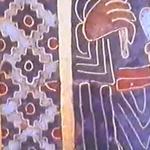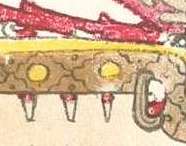"a linkelt wiki szócikk egy árva kukkot nem ír a képekről"
Ez így egyáltalán nem igaz:
"Images of pages 29–46
Pages 29 through 46 of the codex constitute the longest section of the codex, and the most enigmatic.Together these images represent a 20-day period for the veintena cycle. The glyphs refer to dry and rainy seasons. They apparently show a journey but the complex iconography and the lack of any comparable document have led to a variety of interpretations ranging from an account of actual astronomical and historical events, to the passage of Quetzalcoatl—as a personification of Venus[citation needed]—through the underworld, to a "cosmic narrative of creation"....stb."
Tudván, hogy Neked ez nem elég bizonyíték, (korábban is) belinkeltem a másik leírást is, ami részletezi az ábrákat és az alakokat. Nos, a 41. ábra bal függőleges oldalán található az a képrészlet, amit kivágva mutattam meg.
A képrészlet alatt (itt mellett) olvasható:
"der gott (geopferte) Qetzalcouatl" (A feláldozott Quetzalcouatl isten)
A keresztről azért nem ír senki, mert mindenki felismeri, nem kell odaírni, hogy "ez egy kereszt".
A keresztre feszítésről sem, mert ott vannak a szögek is.
Ha már itt tartunk, a magyar koronával is van kapcsolata a 71. képen ábrázolt madár szárnyán látható ún. chakana szimbólumoknak, valamint a bal oldalon látható (Napisten) trónja alatt "lógó" lépcsős piramisoknak a Szt Péter képen látható motívumokkal.
Chakana szimbólum D-Amerikából:

A 71. kép részlete a Borgia kódexből:

Részlet Szt Péter zománcképéről: A fenti kép kinagyított részlete

